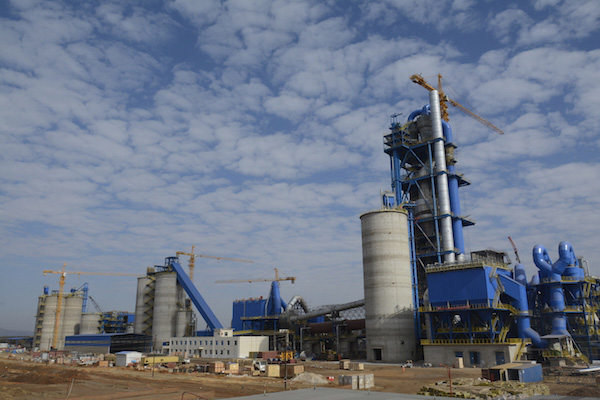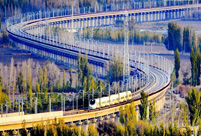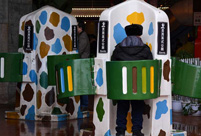


The production line of Mamba Cement’s operations in Limpopo.(Picture: MAMBA CEMENT)
As the South African government devotes itself to transforming its economic landscape and strengthening the delivery of basic services, the nation’s infrastructure development programme will be key in boosting the local building materials market and the prospects of its cement industry in particular.
PPC, SA’s largest cement producer, forecasts that from this year to 2020, growth in the demand for cement is set to continue to outpace GDP growth, and an additional 2.4-million tons will be needed to meet the fore- cast demand.
This positive projection has attracted foreign companies such as Nigerian-backed Sephaku Cement and Chinese-backed Mamba Cement to enter the South African market, as well as many more overseas enterprises in the relevant industries.
While the domestic price of cement is soaring above $90 per tonne, China enjoys half of the price level while grappling with the challenge of overcapacity. Although the annual domestic cement output in China dropped to 2.35-billion tonnes last year — a decline for the first time in 25 years — it still accounts for a 30% excess in output and a 50% excess in capacity.
“Given this environment, the expertise in the Chinese cement industry and ability to operate in a highly competitive environment can be shared and exported to other markets,” said Tao Feng, a director of Mamba Cement.
The South African subsidiary of Jidong Development Group was put into production with the capacity of 1.2-million tonnes per annum in October 2015. Located in Limpopo province, the plant saves up to R160 per ton in production due to its proximity to the major centres of Johannesburg, Pretoria, Mpumalanga, Rustenburg and Brits. This enables Mamba to offer competitive prices in the market.
In a country where it is common for cement plants to be very old, often 40 years or more, the Mamba plant brought new technology — which has also enabled the Chinese cement industry to be highly competitive — into SA. The plant is equipped with internationally-leading technology that “manufactures high quality pure cement with the capacity to produce cost-effective products”, according to Nedbank CIB, one of its funders. Even the waste heat is fully utilised, generating one third of the electricity needed by the plant.
“We’ve put a lot of effort into ensuring that we adopt the highest standard of production and that the development is sustain- able,” said Tao Feng.
The effort is paid back in sales. The company reached off- take agreements with some mass building materials retailers while the plant was still under construction, taking up 60% of its output. Some construction companies and leading local cement suppliers turn to them for orders and collaboration as well.
“The experience the Chinese cement industry has in building cement plant also enabled us to have a shorter commissioning period and the ability to produce stable, quality cement a lot quicker,” Tao Feng added.
Meanwhile, Jidong, being one of the world’s top five cement producers, is training local technicians for Mamba to achieve localisation requirements.
About 168 of Mamba’s 236 staff members are local workers. A number of these employees are being trained by experienced Chinese workers in the operation of a modern cement plant. This includes, for example, the training of skilled local personnel in the operation of the plant’s waste heat recovery system, the first such facility in Africa.
According to the production management and technical sup- port agreement signed earlier between Mamba and Jidong, the number of local employees will increase by a further 50 in the next five years as they become qualified to take over positions currently filled by Chinese staff.
On the subject of localisation, another Chinese manufacturer, China Railway Rolling Stock Corporation (CRRC), has set a model for foreign enterprises trading with SA. Seizing opportunities in SA’s vast rail equipment market, its predecessor CNR and CSR had signed the sales contract for 554 electric locomotives and 232 diesel locomotives respectively with Transnet since 2012. As requested by the contract, up to 60% of the production must be local. To achieve this, CRRC set up plants in Pretoria and in Durban which would be involved in production, assembly, maintenance and refurbishment. Groups of Chinese experts have been transferred to SA to train local workers, some of whom have been sent in groups to receive training in China.
In March 2015, the first 95 electric locomotives were delivered. Local workers at the Pretoria plant assembled 85 of them with guidance from Chinese technicians. Furthermore, the plant is to generate an annual production capacity of 100 loco- motive and rail vehicles.
“During the process of achieving localisation, we transfer our key technologies, create jobs and help Transnet upgrade its manufacturing level,” said Victor Wang, director of CRRC South Africa. “China is pretty advanced in locomotive manufacturing and SA is experiencing a surge in demand for railway-related infrastructure projects. Techno- logical support is needed to assist in staff training, daily operation and maintenance. This could be a win-win collaboration.”
However, the largest export order in China’s high-end rail transit equipment sector also faces challenges. As a new entrant to the South African market, local regulations have created some boundaries for CRRC. Moreover, in what was supposed to be the largest deal it had to cope with a possible 35% loss of margins due to local currency depreciation. It is currently seeking finance provided by commercial banks to mitigate the risk.
From the outset, Mamba’s project risk has been reduced with local financing in rands, thereby eliminating any currency risk. Nedbank and the Bank of China Johannesburg branch have raised R900m in project
finance to fund Mamba. Since it was the first project finance transaction in the local cement industry, negotiations took almost five years to complete.
Jidong and the China Africa Development (CAD) Fund share a combined 51% stake in the project, while SA’s Women Investment Portfolio Holdings holds 23.9% and the Melissa Family Trust has the remaining 25.1%, for an investment of R1.75bn.
Nedbank speaks highly of the business, including its view on the operation’s contribution to local economic development.
“The investment is expected to create jobs and provide opportunities for small suppliers for communities north of Brits. In addition, the sponsors and developers have committed to sup- porting local schools and other socioeconomic development initiatives in the long term. “The project will also result in a major improvement of basic infrastructure such as power and roads, which will benefit adjacent communities,” Nedbank said a statement.
While some major foreign investors are reluctant to do business in SA due to the negative outlook, enterprises such as Mamba are backed by China and encouraged to take that opportunity. One of Mamba’s share- holders, the CAD Fund, the first and largest equity investment fund in China dedicated to investing in Africa, injected another $5bn in capital in December 2015 to better fund Sino-African projects. It foresees that investment in Africa’s railway, highway and aviation networks as well as in production capacity is to be boosted in the near future.
(The story was originally published on Business Day on February 29th, 2016.)
 China has world's largest high-speed rail network
China has world's largest high-speed rail network Top beauties in Chinese provinces
Top beauties in Chinese provinces 600 people attend Lusheng playing contest in S China
600 people attend Lusheng playing contest in S China Engineer troop builds bridge in real combat conditions
Engineer troop builds bridge in real combat conditions You can urinate in public in Chongqing
You can urinate in public in Chongqing Rice terrace scenery in southwest China's Yunnan
Rice terrace scenery in southwest China's Yunnan 2016 Miss Chinatown USA pageant held in San Francisco
2016 Miss Chinatown USA pageant held in San Francisco Ancient pagodas across China
Ancient pagodas across China Wedding dress show up in the air
Wedding dress show up in the air Top 20 hottest women in the world in 2014
Top 20 hottest women in the world in 2014 Top 10 hardest languages to learn
Top 10 hardest languages to learn 10 Chinese female stars with most beautiful faces
10 Chinese female stars with most beautiful faces China’s Top 10 Unique Bridges, Highways and Roads
China’s Top 10 Unique Bridges, Highways and Roads Harris is making waves in S.China Sea
Harris is making waves in S.China Sea With new plant, Airbus seeks to secure China market share
With new plant, Airbus seeks to secure China market share Chinese sound off on America’s loudest presidential hopeful
Chinese sound off on America’s loudest presidential hopeful 40 years after Cultural Revolution, repentance of Red Guards is still rare
40 years after Cultural Revolution, repentance of Red Guards is still rareDay|Week